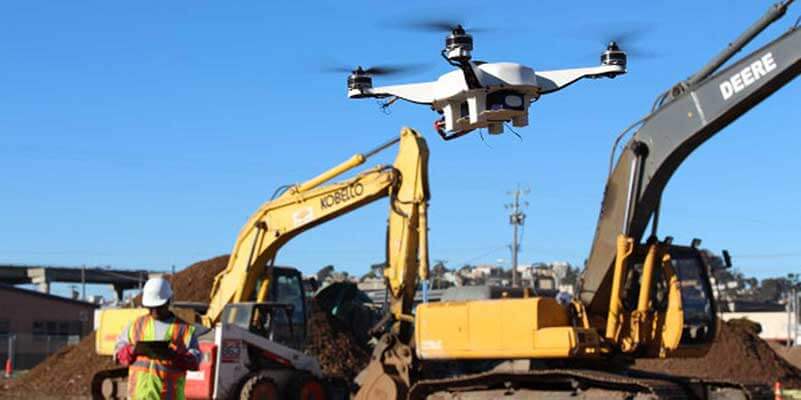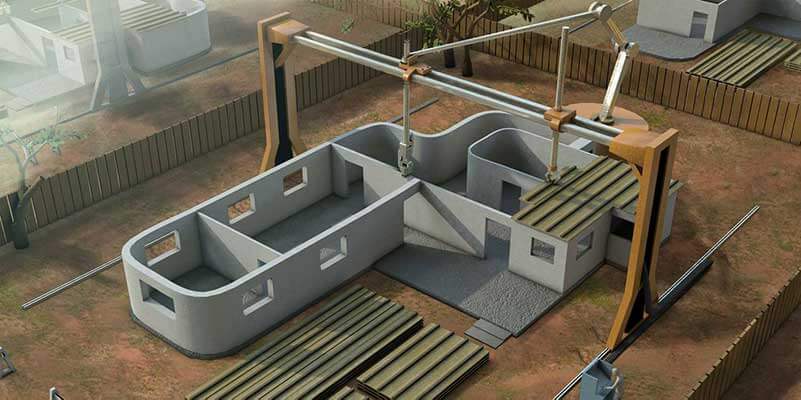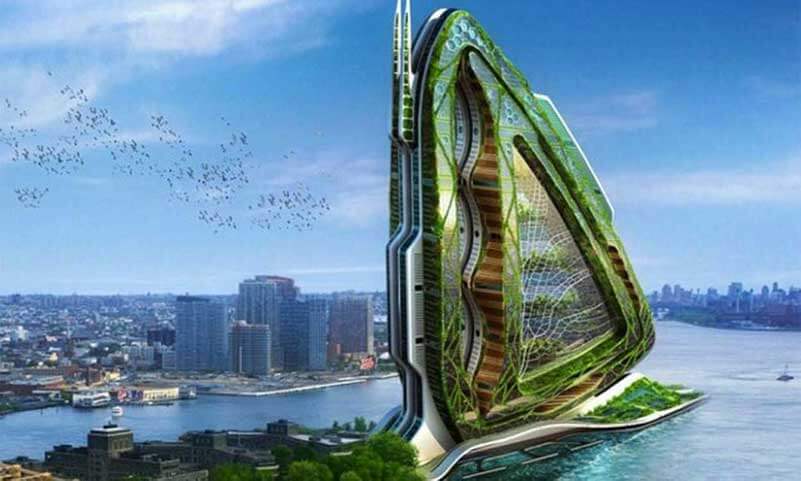- 3D scanning lasers, drones, and robots are increasingly replacing traditional construction tools
- Flying drones on construction sites
- Smart buildings are evolving from mere concepts into reality
- 3D printing of a house
- Building in space: Not sci-fi anymore
- Edible buildings will lead toward a tastier and greener future
- What does all this tell us about the future of construction?
Since the beginning of time, man first tried to build shelters and later proper houses, which ended up being major metropolises with huge buildings and complexes. We produce heavy machinery, vehicles, and many different types of engines to help us accomplish these massive tasks. But can we take a step further? Yes, we can!
Construction is going to be a major turnaround for technology freaks. 3D scanning lasers for surveying, drones for helping construction workers, Google Glass for analyzing sites, and many other different and cool stuff will change our way of constructing infrastructure forever. What if we tell you that a robot will build a bridge with huge clamps? Or what if we go to space and start building our cities on another planet? Well, it’s not science fiction anymore. Construction of infrastructure will undergo a sea change, and it would be in ways you never thought of. Many of these technologies are already in use or in a phase of a prototype – some are still just a dream, with hopes of it coming true in the future.
3D scanning lasers, drones, and robots are increasingly replacing traditional construction tools
Surveying is a major part of any building construction process, and precision is a major part of this task. New technologies are bringing new methods and, sooner than later, we might see 3D laser scanners replacing traditional theodolites for 3D measurements of buildings, bridges, tunnels, and terrains. Traditional ways of surveying in complex situations demand a lot of work, such as drilling, or even impossible surveying of areas dominated by gridlocks of steel or the like. However, 3D laser scanning will definitely change all this by making it almost effortless, as lasers can not only scan unreachable areas but also view and scan quite a long distance, which can be accomplished with only few technicians, rather than a team of people. Robots will help construction workers in completing tasks of carrying heavy blocks and pieces of equipment, climbing and doing jobs that have a higher risk for a human, while traditional construction tools will be replaced with new ones that have much more automation!
Flying drones on construction sites
Using unmanned aerial vehicles (popularly known as drones) may sound like science fiction to many of us today. However, the reality is that they have already made their footprint in the construction industry. They are being used for survey of construction sites as well as in the actual construction process. Going forward, we will have drones flying through existing structures to obtain comprehensive building information for creating 3D digital models! Drones will not only be used for surveying but also to assist in construction. Imagine an intelligent spider-drone that can construct rope bridges by weaving cables into a bridge pattern in the laboratory environment? Sounds like science fiction? Well not anymore, since scientists in Switzerland are already working on these prototypes! Building bridges will be a piece of cake when a fleet of quadcopter drones will start flying on high altitudes where traditional construction equipment cannot easily reach, such as the space between two tall cliffs or skyscrapers. Wait, this is not the ultimate thing! How about a drone with clamps building towers of magnetic blocks? Movies are becoming reality.

Smart buildings are evolving from mere concepts into reality
If you thought intelligence is a prerogative of only humans, think again. Because you may be underestimating the power of technology. Tireless innovations in technology have the capability to transform any lifeless structure of brick and steel into a smart, thoughtful, and interactive entity. Smart buildings will be fitted with a computer (brain) or a network of computers that are connected to each other or to numerous sensors and actuators through a network of high speed wires (nerves). They will sense and work just as a single entity, determining how to maintain their power, heating, cleaning, and many other things that usually their citizens have to determine by themselves. Can you imagine your home pinned with an electronic chip that autonomously interacts with sensors everywhere in the building? You may enter your temperature and lighting preferences and the environment will adjust itself accordingly wherever you go in the building! All those simple errands done automatically by your own home without you having to take care of them sounds simply great – at least to us!
3D printing of a house
Imagine a future in which getting a building made is as easy as visiting a printer’s shop and ordering your wedding card (we assume you are lucky enough to be still unmarried) — and the building is ready before your wedding card is! Believe it or not, that future has already arrived! Constructing buildings may not be done with a lot of workers, technicians, engineers, and heavy machinery. To build your own home, you might just use a 3D or 4D printer! 3D will make building houses easier, but what if buildings change appearance? Morphing 4D buildings will definitely change perception of construction forever. One day, you pass by a building with multiple stories and a closed top, and the other day, it has an open story with pools on it. Smart material will be programmable to morph into something else, such as transportation to space in rockets, where it can easily reassemble to form satellites and space stations.

Building in space: Not sci-fi anymore
One of the reasons behind mankind’s adventurous ambition of living in space is to ensure the survival of humanity in case of a global disaster, prevent over-exploitation of the limited land space on earth, and create wealth by exploiting space resources. In simple words, after messing up the Earth bad enough to make it practically unlivable, we will go and live in space. Colonizing space was always something we thought as distant future; however, mankind has to find new places of habitat to prevent a complete disaster in the future. We already have space stations, don’t we? Well, then what keeps us from evolving space stations into space cities? Probably, finding a suitable planet and interplanetary travel. As technology progresses, we will see more and more of outer space exploration and travel, with colonization of new planets! Will “home sweet home” move to another planet and construction machinery in space? We will wait and see.
Edible buildings will lead toward a tastier and greener future
Edible buildings may sound like a child’s dream – palaces and castles made from chocolates, cakes, pastries, and other delicacies. However, and rather disappointingly for a chocolate lover, it only means buildings that can grow edible stuff such as green vegetables on its walls and roofs. Imagine a self-sufficient hotel with farming and gardening on it and that too in a green urban landscape? How about an edible hotel with a “wall” that uses the vertical farming technologies of hydroponics and aquaponics to produce enough food to subsidize two-thirds of the hotel’s meals? Implementing agriculture, constructing green roofs, and bringing vegetables within the city is going to be a major trend in the future, and some are already exploiting the potential. Urban areas have been having a huge problem with pollution for a long time. This could be partially solved by making these areas more greener, helping them “vegetate” in a way. If we can make a building that has its all functions and comfort combined with green areas within it, which are sustainable as well, we would actually have a building with a park or garden in it! This would surely be a major element in making people enjoy a much better living inside an urban area, where they can attend to their garden and have the feeling of being in a green area, park, or woods, when in fact they are still in their residential building.

What does all this tell us about the future of construction?
First of all, it is quite clear that technology can help a lot in the process of structure building. Heavy lifting can be done easily with the help of a robot and machines such as drones can fly around the construction site, connecting wires and scanning the area, while an engineer can safely stand in one spot, track progress through sensors or 3D scanner lasers. Connecting every machine in the construction site will give us a lot of information, which could be used to analyze the best possible approach toward building a better house or bridge. The biggest expectations are probably from building new colonies in space, and making structures with morphing material such as 4D, where the material will change the look of the building, depending on various conditions. Building stuff will always be a focus for mankind; it has been before as well – take, for example, the pyramids and all these theories about aliens constructing them.
We will always look for a way to build something magnificent, and always search for something bigger, more complex, or radical! Building in space, morphing material, or 3D printing are few of such things. If you build a bridge, it only has a function of a bridge, but what if it can morph its material into another building at some point? Possibilities are limitless – we can never know what can happen, but we can be sure that things are going to change a lot in construction, both for us and construction workers. If we want our house built, we might not get a group of people doing it anymore; instead, there would be robots carrying stuff or drones flying and doing the job, while an engineer might just scan the area and supervise what robots do. All this data will be transmitted with sensors and analyzed by computers in a construction company, where big data will be a key for many decisions, such as which material is to be used where, or how to solve the problem of air ventilation and the like.
Share via:

